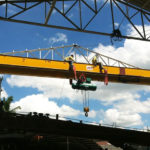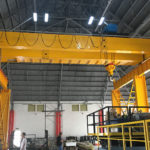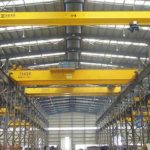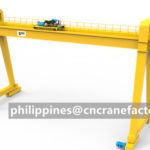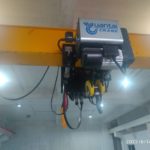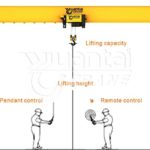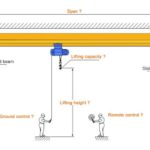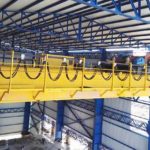Overhead and Gantry Crane Safety and Requirements
Moving large, heavy loads is crucial to today’s manufacturing and construction industries. Safe crane operation involves not only using the correct type and size of crane for the job, but also making sure the crane is in good condition before each use.
General Requirements for Overhead and Gantry Cranes

The following requirements apply to all industrial cranes used in the workplace, including automatic, cab-operated, gantry, semi-gantry, wall, jib, bridge, etc.
- The rated load capacity of the crane should be plainly marked on each side of the bridge or jib. The load capacity should be clearly legible from ground level.
- If the crane has more than one hoisting unit, the rated load capacity should be marked on each load block.
- The rated working load capacity and manufacturer’s name should be forged or die stamped on a low stress and non-wearing area of each hook. Hooks without this information should be tagged “Do Not Use” and removed from service until the load rating can be determined.
- Hoist hooks should not be cracked, stretched, bent, or twisted. Each hook should have a safety latch that automatically closes the throat of the hook. If the latch is bent, spring is broken, or otherwise damaged, the latch should be repaired before use.
- Alloy chains and slings should be equipped with permanently affixed, legible and durable identification tags stating size, grade, rated capacity and reach.
- Synthetic web slings should be marked or coded to show the rated capacities for each type of hitch and type of synthetic web material.
- Cab-operated cranes should be equipped with a multipurpose fire extinguisher. Operators should be trained on the use of extinguishers before being assigned to the job.
Daily Inspection Procedures for Overhead and Gantry Cranes


An active crane inspection program and periodic maintenance contribute to safe crane operations. Frequency of use is a key factor in determining how often the crane should be inspected and serviced, but several items should be inspected daily. Yuantai Crane requires a visual inspection of the following items before use:
- Check that the crane or hoist is not tagged with an out-of-order sign.
- Check that warning and safety labels are not missing and are legible.
- Check for any sign of oil leakage on the crane and on the floor/ground beneath the crane.
- Inspect for smooth hoisting and lowering, trolley and bridge travel. Listen for any unusual sounds.
- Test operation of the primary limit switch of the hoisting motion.
- Verify that the trolley and crane braking systems are functioning properly before continuing with travel.
- Visually inspect Wire Rope Hoists for broken wires, broken strands, kinks, and any other damage of the wire rope structure, such as “bird caging.” Check that the wire rope is properly reeved and that rope parts are not twisted about each other.
- Visually inspect chain hoists for excessive wear, cracks, gouges, twists, kinks, or stretching beyond the manufacturer’s recommendations. Check that the chain is in the upper and lower sprockets and in the chain guide.
- Visually inspect hooks for cracks, gouges, deformation of the throat opening, wear on saddle or load bearing point, and twisting. Refer to the original equipment manufacturer’s manual for acceptable tolerances.
- Visually inspect hook latches for damage that does not allow proper operation.
- Check the condition and capacity of nylon or synthetic web slings. Capacity ratings should be legible on the manufacturer’s label.
Monthly Inspection Procedures of Gantry Crane and Overhead Crane

Yuantai Crane also requires a more thorough crane inspection periodically, anywhere from one to twelve-month intervals. As a best practice, EMC recommends performing these inspections monthly.
Inspection Procedures for Intermittently Used Cranes
Cranes not in regular use, such as standby cranes, should also be periodically inspected to ensure safe operation. Yuantai classifies inspection requirements as shown below:
- A crane which has been idle for a period of 1 month or more, but less than 6 months, should be given an inspection consisting of all the items listed under “Daily Inspection Procedures” before placing into service. In addition, all rope that has been idle for a period of a month or more due to shutdown or storage of a crane on which it is installed should be given a thorough inspection before use.
- A crane that has been idle for a period of over 6 months should be given a complete inspection consistent with the items listed under “Monthly Inspection Procedures” before being placed into service. The Crane Inspection Report should be completed in conjunction with this inspection.
Additional Safety Guidelines for Cranes
The following general safety rules should be communicated to all crane operators:
- Never exceed the crane’s rated load capacity. When lifting loads at or near capacity, test the hoist brakes.
- Locate the hoist directly above the lifting point of the load before lifting. Loads should always be balanced and secured. Make a preliminary lift of a few inches to ensure the load is balanced.
- Take it slow. Avoid sudden acceleration and deceleration.
- Remove slack from the sling, chain, or cable before lifting a load.
- Loads should not be suspended over personnel below.
- Never allow anyone to ride on the hook or load at any time.
- Never leave the controls unattended while a load is suspended.
- Become familiar with the location of the crane/hoist disconnect switch. If electrical power is lost, place controls in the OFF position to prevent unexpected start up.
- Disconnect power to a hoist that is unsafe or in need of repair.
Safety Tips for Overhead Crane Operation
1) Before use, ensure the crane is suitable for the planned hoisting task. Confirm it has appropriate travel, lift, and capacity.
2) Visually and physically inspect the crane before use. Check for damage, wear, and proper operation of all functions.
3) Confirm the load weight. Check the capacity of all equipment including the hardware, rope, and slings. Do not exceed these capacities.
4) Select the right sling for each lift. Inspect slings and other rigging hardware before use for wear, stretch, or other damage. Do not use damaged or defective slings. Use softeners around sharp corners. Do not splice broken slings.
5) When communicating with a crane operator, use clear agreed-upon signals. Except for the stop signal, the crane operator should follow instructions from only one person – a designated signaler. Where a wired or Remote Controller is used, the operator should become familiar with all of its functions before lifting the load.
6) Warn all people in the load lift area before starting the lift. Ensure that the path of the load is clear of persons and obstructions. Do not lift loads over anyone. Center the crane hoist over the load before hoisting to prevent swinging of the load.
7) Slide the sling fully onto the hoisting hook and ensure the safety latch is closed. Do not load the hook tip or hammer a sling into place.
8) Secure unused sling legs. Do not drag slings or leave loose materials on a load being hoisted.
9) Keep hands and fingers from being trapped when slack is taken out of a sling. Step away before the lift is started.
10) Move the load and controls smoothly. Minimize load swing.
11) Walk ahead of the load during travel and warn people to keep clear. Use a tagline to prevent rotation or other uncontrolled motion. Raise the load only as high as necessary to clear objects. Do not ride on the hook or load.
12) Set loads down on blocking, never directly on a sling. Do not pull or push loads out from under the hoist.
13) Do not leave the load (or the crane) unattended while the load is suspended.
14) Where crane operation by other personnel must be restricted, employ lockout and tagging procedures.
15) Store slings off the floor in a clean, dry location on hooks or racks. Do not leave slings, accessories, or blocking lying on the floor.
